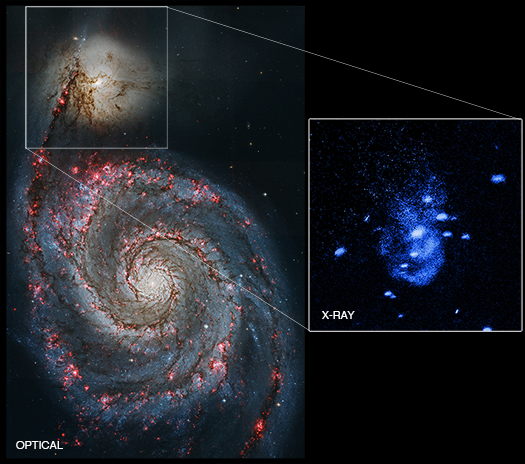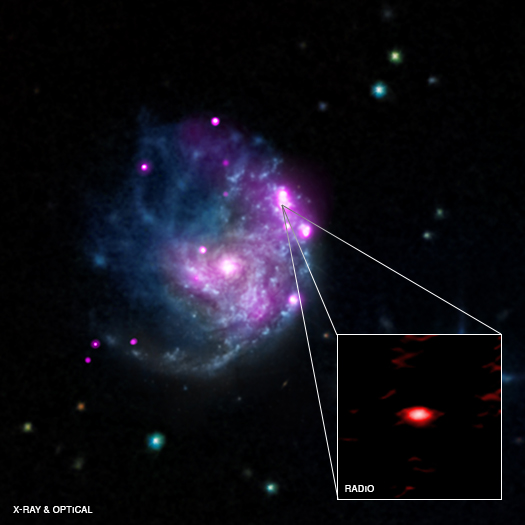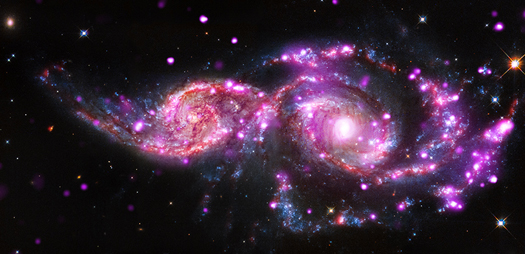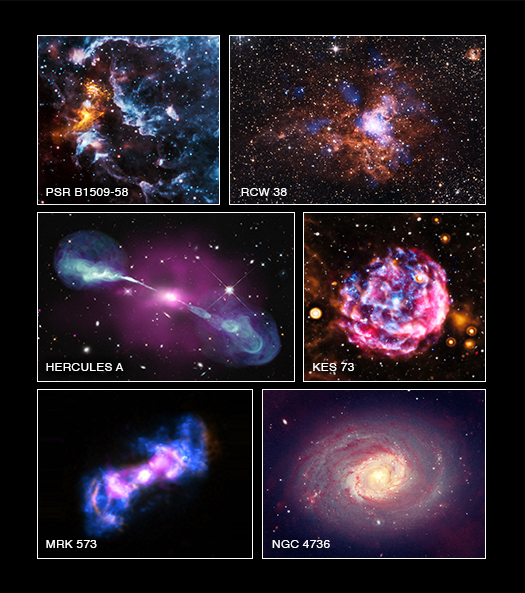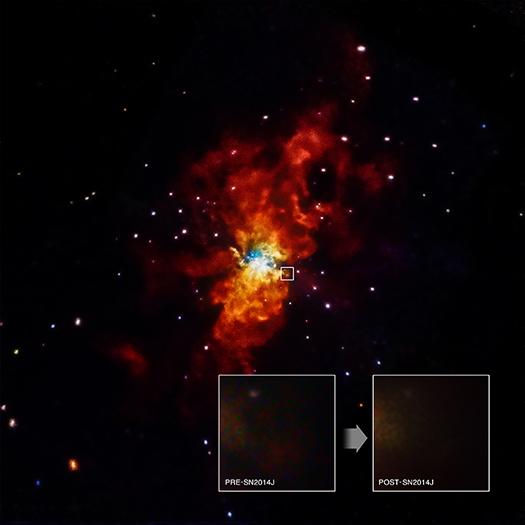Normal Galaxies & Starburst Galaxies
The Arrhythmic Beating of a Black Hole Heart
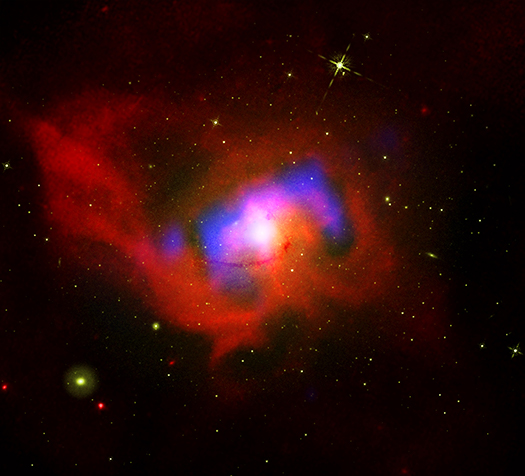
NGC 4696
At the center of the Centaurus galaxy cluster, there is a large elliptical galaxy called NGC 4696. Deeper still, there is a supermassive black hole buried within the core of this galaxy.
New data from NASA's Chandra X-ray Observatory and other telescopes has revealed details about this giant black hole, located some 145 million light years from Earth. Although the black hole itself is undetected, astronomers are learning about the impact it has on the galaxy it inhabits and the larger cluster around it.
In some ways, this black hole resembles a beating heart that pumps blood outward into the body via the arteries. Likewise, a black hole can inject material and energy into its host galaxy and beyond.
By examining the details of the X-ray data from Chandra, scientists have found evidence for repeated bursts of energetic particles in jets generated by the supermassive black hole at the center of NGC 4696. These bursts create vast cavities in the hot gas that fills the space between the galaxies in the cluster. The bursts also create shock waves, akin to sonic booms produced by high-speed airplanes, which travel tens of thousands of light years across the cluster.
Super Starburst Galaxy Found One Billion Years After the Big Bang

Jingzhe Ma
We are pleased to welcome Jingzhe Ma as a guest blogger. She is the first author of a paper that is the subject of our latest press release. Jingzhe is a PhD candidate at the University of Florida, working with Prof. Anthony Gonzalez and Prof. Jian Ge. She is going to defend her PhD dissertation next summer. She has been working on the formation and evolution of high-redshift dusty galaxies through multi-wavelength observations. She joined the South Pole Telescope Sub-Millimeter Galaxy (SPT SMG) Collaboration led by Prof. Joaquin Vieira in 2012.
When Prof. Anthony Gonzalez first introduced me to the SPT SMG group, I was fascinated by the sub-millimeter galaxies discovered by the South Pole Telescope, which is located at the geographic South Pole. We call them sub-millimeter galaxies because these galaxies were historically first discovered at sub-millimeter wavelengths (slightly shorter than one millimeter). They are bright at these wavelengths but very faint in the visible wavelengths due to the large amount of dust in these galaxies. Dust plays an important role, by absorbing and scattering the ultraviolet and visible light from newborn stars. The dust gets heated and re-radiates light in the infrared. I was interested in further studying these objects not only because these galaxies are forming stars at tremendous rates and have revolutionized our understanding of galaxy evolution, but also because these galaxies are magnified by massive foreground galaxies, which act as a gravitational lens. “Wearing” a gravitational lens, we are able to see better.
NASA's Chandra Finds Supermassive Black Hole Burping Nearby
Astronomers have used NASA's Chandra X-ray Observatory to discover one of the nearest supermassive black holes to Earth that is currently undergoing powerful outbursts, as described in our latest press release. This galactic burping was found in the Messier 51 galaxy, which is located about 26 million light years from Earth and, contains a large spiral galaxy NGC 5194 (also known by its nickname of the "Whirlpool"), merging with a smaller companion galaxy NGC 5195.
Growing Black Holes: Hunting for the First Seeds

Mar Mezcua
We are pleased to welcome Mar Mezcua as a guest blogger today. She led the study that is the subject of our latest press release, about an intermediate mass black hole. Mar is from Balaguer (Lleida, Spain) and studied Physics in the University Autonomous of Barcelona and in the University of La Laguna, where she also specialized in Astrophysics. She completed her PhD at the Max-Planck-Institut fuer Radioastronomie (Bonn, Germany) in 2011 and then moved to the Instituto de Astrofisica de Canarias (Canary Islands, Spain) as a postdoctoral researcher. She is currently a postdoctoral researcher at the Harvard-Smithsonian Center for Astrophysics.
I found my calling when I was 13 years old and serendipitously watched a documentary on TV about galaxies and supermassive black holes. I wanted to become an astrophysicist and study these exciting objects!
Supermassive black holes reside at the center of galaxies and are more than a million times more massive than the Sun. As their name implies, they are black and thus cannot be observed directly. Hence, to detect black holes we have to observe the matter that surrounds and feeds them, this is, the material that the black hole “accretes.” In supermassive black holes, this accreting material heats up high enough to emit X-rays so that we can detect it with X-ray satellites like NASA’s Chandra X-ray Observatory. Some supermassive black holes also eject outflows of plasma or jets, which emit mainly at radio wavelengths.
NASA's Chandra Finds Intriguing Member of Black Hole Family Tree
A newly discovered object in the galaxy NGC 2276 may prove to be an important black hole that helps fill in the evolutionary story of these exotic objects, as described in our latest press release. The main image in this graphic contains a composite image of NGC 2766 that includes X-rays from NASA's Chandra X-ray Observatory (pink) combined with optical data from the Hubble Space Telescope and the Digitized Sky Survey (red, green and blue). The inset is a zoom into the interesting source that lies in one of the galaxy's spiral arms. This object, called NGC 2276-3c, is seen in radio waves (red) in observations from the European Very Long Baseline Interferometry Network, or EVN.
Galactic Get-Together has Impressive Light Display
At this time of year, there are lots of gatherings often decorated with festive lights. When galaxies get together, there is the chance of a spectacular light show as is the case with NGC 2207 and IC 2163
Located about 130 million light years from Earth, in the constellation of Canis Major, this pair of spiral galaxies has been caught in a grazing encounter. NGC 2207 and IC 2163 have hosted three supernova explosions in the past 15 years and have produced one of the most bountiful collections of super bright X-ray lights known. These special objects - known as "ultraluminous X-ray sources" (ULXs) - have been found using data from NASA's Chandra X-ray Observatory.
Our Universe in Color
Today we released six new images from Chandra’s vast data archive. Each one of these astronomical images combines X-rays from Chandra with data from telescopes that detect different types of light such as infrared, radio, and visible light.
Chandra's Archives Come to Life
Every year, NASA's Chandra X-ray Observatory looks at hundreds of objects throughout space to help expand our understanding of the Universe. Ultimately, these data are stored in the Chandra Data Archive, an electronic repository that provides access to these unique X-ray findings for anyone who would like to explore them. With the passing of Chandra's 15th anniversary in operation on August 26, 1999, the archive continues to grow as each successive year adds to the enormous and invaluable dataset.
Suspected Black Hole Unmasked as Ultraluminous Pulsar
An Ultraluminous X-ray Source (ULX) that astronomers had thought was a black hole is really the brightest pulsar ever recorded. ULXs are objects that produce more X-rays than most "normal" X-ray binary systems, in which a star is orbiting a neutron star or a stellar-mass black hole. Black holes in these X-ray binary systems generally weigh about five to thirty times the mass of the sun.
NASA's Chandra Observatory Searches for Trigger of Nearby Supernova
New data from NASA's Chandra X-ray Observatory has provided stringent constraints on the environment around one of the closest supernovas discovered in decades. The Chandra results provide insight into possible cause of the explosion, as described in our press release.

